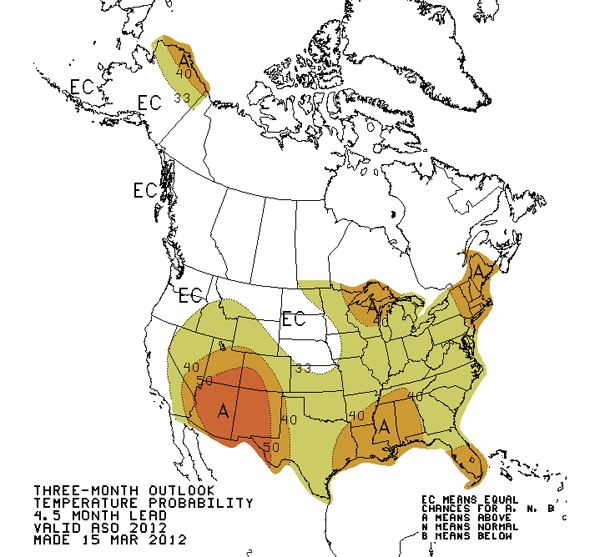Texas Electricity Market Could Have a Rough Summer in 2012
The Texas grid is operated by the Electric Reliability Council of Texas (ERCOT) and is separate from the other North American power grids. ERCOT is battling on multiple fronts to maintain enough power to meet demand as weather extremes, economic pressures and environmental regulations conspire to tip the often delicate balance between the demand for electricity and the available supply.
After a difficult year in 2011, the challenges on the grid have not abated in 2012. The National Weather Service Climate Prediction Center is forecasting a 40% chance of a hotter than normal summer this year. Based partially on this data ERCOT has raised its estimate for peak demand on the grid this summer. The Texas grid did not have the wiggle room for this.

Source: noaa.gov
The Weather
In February of 2011 Texas was slammed with unprecedented winter storms. In the Dallas/Fort Worth area in North Texas the average annual snowfall is about 2.5 inches. A single storm in February dropped almost a foot of snow in some places. In Texas where people are not accustomed to heavy winter weather the response is to hunker down, stay home with the heat running, and wait for the thaw. Though certainly a reasonable response, this can put strain on the grid when all of the heaters, hot water units and televisions run at the same time. This simultaneous surge in demand brought the grid to the edge of capacity. When the frigid cold caused mechanical failure at certain key power nodes the grid exceeded capacity leaving grid operators with no option but to institute controlled blackouts to maintain the integrity of the system as a whole.
The summer months in Texas again brought record temperatures at the other extreme. The months of June through August in Texas were officially the hottest 3 months ever recorded in the United States eclipsing the infamous Dust bowl of the 1930’s. Electric companies in Texas struggled to provide enough power to meet demand during a string of 100° days that lasted the entire summer. Another round of rolling blackouts was narrowly avoided only by calling on the public to voluntarily undertake conservation measures and avoid certain activities during peak demand times of the day.
The Regulators
Texas has been engaged in a very public standoff with the EPA over the new Cross-State Air Pollution Rule which ERCOT claims will close down power plants at the very time when electric supply is already short. Texas was one of several entities to seek relief from enforcement of the rules in federal court. In the 11th hour the court gave grid operators temporary relief by blocking enforcement of new rules schedule to take effect January 1st which would have immediately led to some power plants closing down. Other plants would have likely closed down due to the expensive upgrades that would have been required to comply with the rules meant to reduce emissions from coal powered electric plants.
The EPA is standing by both the new rules and the timing of their implementation claiming that thousands of lives will be saved by the new guidelines and asserting that Texas had ample time to prepare for the new rules and account for them in their planning.
The Economy
Cheap electricity rates in Texas have been a mixed blessing. Due in large part to the natural gas boom and subsequent plunge in natural gas prices electricity rates in Texas are currently at multiyear lows. This has been welcomed by consumers in Texas. But, electricity regulation can sometimes create a cutthroat environment among retail electricity providers.
The downside of cheaper electric rates for wholesale electric producers is the lack of economic incentive to develop more power plants. While the Texas economy was not left untouched by the recession it has fared better than most other parts of the country. This has created a situation where electric demand has remained strong while supply has not kept pace. With regulatory and economic pressure causing the Texas grid to skirt on the edge of capacity there is less and less fault tolerance within the system.

Source:ERCOT
To encourage power producers to invest in new capacity the Texas Public utility commission is working on a plan to increase the cap on wholesale electricity rates. Retail electric providers who are not well hedged could find themselves in trouble if wholesale prices spike. Longer-term fixed rate contracts with customers could prevent them from passing the costs along immediately. However, in the long term this will inevitably lead to higher electricity prices for consumers.
Rough Summer Ahead
ERCOT is implementing several measures to survive the summer including potentially bringing old power plants that are currently idled back online. They are also working with the PUC to update rules related to who can participate in emergency demand response programs. There are concerns that Texas lags the rest of the country in the implementation of a more robust demand response program. According to the Federal Energy Regulatory Commission, Texas could add up to 19 GW in capacity by 2019 with a more aggressive demand response program. Potential rule changes include increasing the required response time of 10 minutes for participants to react to a DR signal. Such a change could greatly increase the pool of participants in the program.

Source: FERC
ERCOT is warning that generation capacity is “expected to be tight” this summer with projected capacity uncomfortably close to expected peak demand. ERCOT warns “there is a significant chance that ERCOT will need to declare an Energy Emergency Alert (EEA) on multiple occasions during the summer of 2012 and issue corresponding public appeals for conservation.”
This report reprinted with permission from the Texas Chamber of Commerce Energy Association








